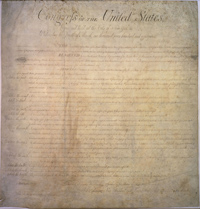The U.S. National Archives describes the creation of the Bill of Rights on its  website, as follows:
website, as follows:
“The call for a bill of rights had been the anti-Federalists’ most powerful weapon… The anti-Federalists, demanding a more concise, unequivocal Constitution, one that laid out for all to see the right of the people and limitations of the power of government, claimed that the brevity of the document only revealed its inferior nature. Richard Henry Lee despaired at the lack of provisions to protect ‘those essential rights of mankind without which liberty cannot exist.’…
A bill of rights had been barely mentioned in the Philadelphia convention, most delegates holding that the fundamental rights of individuals had been secured in the state constitutions. James Wilson maintained that a bill of rights was superfluous because all power not expressly delegated to the new government was reserved to the people. It was clear, however, that in this argument the anti-Federalists held the upper hand. Even Thomas Jefferson, generally in favor of the new government, wrote to Madison that a bill of rights was ‘what the people are entitled to against every government on earth.’
By the fall of 1788 Madison had been convinced that not only was a bill of rights necessary to ensure acceptance of the Constitution but that it would have positive effects. He wrote, on October 17, that such ‘fundamental maxims of free Government’ would be ‘a good ground for an appeal to the sense of community’ against potential oppression and would ‘counteract the impulses of interest and passion.’
Madison’s support of the bill of rights was of critical significance. One of the new representatives from Virginia to the First Federal Congress, as established by the new Constitution, he worked tirelessly to persuade the House to enact amendments. Defusing the anti-Federalists’ objections to the Constitution, Madison was able to shepherd through 17 amendments in the early months of the Congress, a list that was later trimmed to 12 in the Senate. On October 2, 1789, President Washington sent to each of the states a copy of the 12 amendments adopted by the Congress in September. By December 15, 1791, three-fourths of the states had ratified the 10 amendments now so familiar to Americans as the ‘Bill of Rights.'”
>National Archives and Records Administration
Houghton Mifflin describes the creation of the Bill of Rights on their website, as follows:
“In 1787, at the Constitutional Convention in Philadelphia, Mason remarked that he ‘wished the plan had been prefaced by a Bill of Rights.’ Elbridge Gerry moved for the appointment of a committee to prepare such a bill, but the delegates, without debate, defeated the motion. They did not oppose the principle of a bill of rights; they simply thought it unnecessary, in light of the theory that the new federal government would be one of enumerated powers only. Some of the Framers also were skeptical of the utility of what James Madison called ‘parchment barriers’ against majorities; they looked, for protection, to structural arrangements such as separation of powers and checks and balances.
Opponents of ratification quickly seized upon the absence of a bill of rights, and Federalists, especially Madison, soon realized that they must offer to add amendments to the Constitution after its ratification. Only by making such a pledge were the Constitution’s supporters able to achieve ratification in such closely divided states as New York and Virginia….
Within six months of the time the amendments—the Bill of Rights—had been submitted to the states, nine had ratified them. Two more states were needed; Virginia’s ratification, on December 15, 1791, made the Bill of Rights part of the Constitution. (Ten amendments were ratified; two others, dealing with the number of representatives and with the compensation of senators and representatives, were not.) ”
The Reader’s Companion to American History, Houghton Mifflin
The University of Groningen describes the creation of the Bill of Rights on their website, as follows:
“Antipathy toward a strong central government was only one concern among those opposed to the Constitution; of equal concern to many was the fear that the Constitution did not protect individual rights and freedoms sufficiently. Virginian George Mason, author of Virginia’s 1776 Declaration of Rights, was one of three delegates to the Constitutional Convention who refused to sign the final document because it did not enumerate individual rights. Together with Patrick Henry, he campaigned vigorously against ratification of the Constitution by Virginia. Indeed, five states, including Massachusetts, ratified the Constitution on the condition that such amendments be added immediately.
When the first Congress convened in New York City in September 1789, the calls for amendments protecting individual rights were virtually unanimous. Congress quickly adopted 12 such amendments; by December 1791, enough states had ratified 10 amendments to make them part of the Constitution. Collectively, they are known as the Bill of Rights.”
An Outline of American History, chapt. 4, Ratification of the Bill of Rights, University of Groningen, The Netherlands.